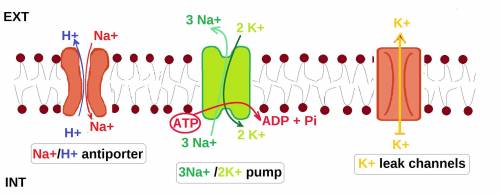
Biology, 08.03.2021 19:50 unknown54321
You are studying ion channels and have set up model lipid vesicles containing the three following transporters:
1. a Na+ /H+ antiporter driven by the Na+ concentration gradient.
2. The common 3Na+ /2K+ pump.
3. K+ leak channels. The experiments are designed such that all three transporters are oriented in the model lipid bilayers in the same direction they would be in the plasma membrane of a cell and that concentration gradients in vitro mimic the concentration gradients experienced by cells (e. g., the extracellular Na+ concentration is similar to the concentration outside of the vesicle whereas the concentration in the lumen of the model vesicles is similar to intracellular Na+ levels).
Required:
a. Draw the arrangement and ion flow of the three types of transporters in the model membranes.
b. What do you predict will happen to the pH of the vesicle lumen if you treat the model membranes with the drug oubain that impairs function of the 3Na+/2K+ pump? Briefly explain your answer in terms of what happens with each transporter.

Answers: 1


Another question on Biology

Biology, 21.06.2019 20:30
How can scientists test their ideas about the origin of the universe if they can't physically interact with or study?
Answers: 2

Biology, 22.06.2019 05:30
Can bacteria reproduce in a way such that when you start out with two bacteria, you get five bacteria? why or why not? * a. yes, because bacteria reproduce sexually, and can produce any number of offspring, just as humans do. b. no, because bacteria grow at an exponential rate. c. no, because when bacteria reproduce, they split into two parts, and two bacteria splitting would result in four bacteria.
Answers: 1

Biology, 22.06.2019 08:30
Which member of the following food chain will be least affected by ddt, a pesticide water pollutant, if bio-magnification is occurring? algae> zooplankton> crayfish> leopard frog> large mouth bass
Answers: 3

Biology, 22.06.2019 10:50
The small molecule cyclic amp (camp) takes about 0.2 second to diffuse 10 μm, on average, in a cell. suppose that camp is produced near the plasma membrane on one end of the cell; how long will it take for this camp to diffuse through the cytosol and reach the opposite end of a very large cell, on average? assume that the cell is 200 μm in diameter.
Answers: 1
You know the right answer?
You are studying ion channels and have set up model lipid vesicles containing the three following tr...
Questions

Chemistry, 05.01.2021 18:50


Law, 05.01.2021 18:50

Arts, 05.01.2021 18:50



Mathematics, 05.01.2021 18:50

Chemistry, 05.01.2021 18:50


Mathematics, 05.01.2021 18:50

History, 05.01.2021 18:50

Mathematics, 05.01.2021 18:50

Mathematics, 05.01.2021 18:50


Mathematics, 05.01.2021 18:50

Mathematics, 05.01.2021 18:50

Mathematics, 05.01.2021 18:50


Mathematics, 05.01.2021 18:50

Mathematics, 05.01.2021 18:50




